The second US-based British Tank Killer
After the Sherman Firefly, also equipped with the same ordnance, the 17 Pdr, Self-Propelled Achilles was the second and best-known of these "up-gunning" attempts in WW2. It was trigerred by the availability of the M10 Wolverine through lend-lease, just like the M4 Sherman and shared most components. After several months to adapt the available 17-pdr antitank gun, Royal Arsenal from Woolwich managed to convert all these to the new gun, taking adavantage of the open, larger turret compared to the Sherman's, far more cramped. The "Wolverine" nae which came from the Fisher Tank Arsenal Grand Blanc, Michigan (the "wolverine state") which produced the base vehicle, was called "Achilles" apparently after a suggestion by Churchill. The vehicle soldiered mostly from Normandy, 1944, but was in numbers afterwards, with a total of 1,100 converted by V-Day, over 1,650 M10s received via lend-lease.Development
The blitzkrieg campaign in the west had the US armor doctrine looking for lightly armoured vehicles with high-velocity anti-tank guns to deal with fast-moving German tanks. The M10, which arrived in late 1942, based on the chassis of the M4 Sherma exchanged the original armor for a thinner sloped armor, associated with an open-topped turret, also assembled with sloped plates, in order to reach better speeds by the weight savings, and also for the crew to have a better awareness of their environment.Also in mid-1942, the British examined ways of designing a low-silhouette self-propelled anti-tank gun with fully traversing turret, but in their case, with an armour able to resist a German 5 cm KwK 39 L/60, as fitted in the Panzer III J fielded at the time in North Africa. This new Britush Tank Hunter was about to make a first hit at 800 yards, and so the only way was to dicth the common Ordnance QF 6-pounder which started to replace the obsolete 2-pdr, for the new 17 pounder anti-tank gun. The arrival of the M10 changed British plans and the planned turreted self-propelled gun program was ditched as it was throught faster to adopt the readily available American vehicle. Deliveries however were slow.
Another discovery in the North African campaign, was the effectiveness of the AEC Mk I Gun Carrier "Deacon". The Valentine tank was also looked for a basis, but without turret, to be fitted with the 17pdr, creating the Archer in 1944, and of course the Cruiser VIII Challenger or the late-war A30 Avenger tank hunter, and on the pinnacle of all these, the "universal tank" A34 Cruiser X Comet in 1945.
British adoption of the M10
The British evaluated the M10 and estimated it provided a good protection against the 50 mm (also most common German anti-tank gun in North Africa, as the PAK 38). The M10 was thoroughly examined by the Royal Ordnance, 1943, and authorized on US side for lend-lease. They were open-topped, rare in British practice, mounting not the standard-issue M3 Gun on the Sherman, but a new a 3-inch (76.2 mm) M7, significantly more powerful than the British Ordnance QF 6 pounder. It was found equal in power to the German 7.5 cm KwK 40 now on the Panzer IV and Sturmgeschütz IIIs fielded in Tunisia.A total of 1,648 M10s would be supplied by the United States until 1945, redesignated "3 inch Self-propelled Mount M10" and abbreviated as "3-in SPM M10". These were mid-production. Later ones, caracterized by their "wedge" counterweight became the "3in SPM M10 Mk I" in british service, and the later M10 with "duck bill" counterweight became the "3in SPM M10 Mk II".
Soon, the British saw the advantages of fitting the 17-pdr on this vehicle and in all, seome 1,017 of these (all version confounded) were up-gunned with 17-pounder, a process that started from May 1944 and went until April 1945. The new designation was for all basis, the same "Achilles". They had a "C" suffix added on the M10 but "17pdr M10" became standard.
Most were converted in late 1944/early 1945 based on the 3in SPM M10 Mk II with duck bill counterweight, better balanced for the 17-pdr.
About the 17-pdr

The Ordnance Quick-Firing 17-pounder translated into 76.2 mm (3 inches). Probably the best and most iconic antitank gun of the allies in WW2. Developed from 1940 already to replace the QF 6-pounder, prototypes were tested from mid-1942 up to early 1943 and it was first operational in the Italian Campaign. used on its own carriage, it was also adapted on many British tanks. The APDS shot was a game changer, enabling the destruction of all but the thickest armour of German tanks. After the war it was replaced by the 120 mm BAT recoilless rifle and 84 mm 20 pounder, but its legacy and cold war variants created a legacy which endures to this day.
17pdr ammunitions | APCBC | 140mm/500 m (550 yd), 131 mm/1,000 m (1,100 yd)/30°* | APDS** | 209mm (8 in)/500 meters, 192 mm/1,000 meters /30° | HVAP*** | 140 mm/500 m, 127 mm/1,000 m /30° |
**Armour-piercing discarding sabot: Poor accuracy.
***High-Velocity Armour Piercing - Small quantities.

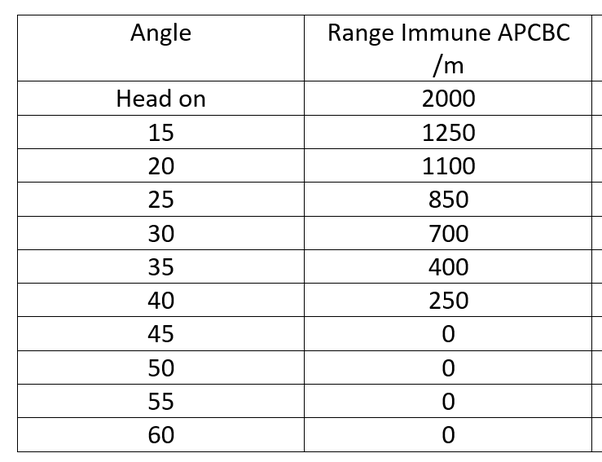

Accuracry, penetration, range and first shot stats, from MORU Report 33 Tank Battle Analysis
Design modifications
The gun mantlet needed modifications to accept the new long barrel. The 17-pounder had a similar bore to the 3-inch gun M7, but the barrel was much longer and thus, also used a larger propellant charge (and longer round). This made all the difference in terms of armor penetrating capabilities. The 17pdr SP was already in widespread use or in deployment in the British, Canadian and Polish armies in Italy and later in northwest Europe, so the ordnance supply chain was already well established.Two major modifications were made: To rebalanced the gun, which was much longer and displaced the light turret's gravity center further forward, a new, larger counterweight was designed and installed. Also to cope with the higher recoil of the new gun, its muzzle was fitted with a caracteristic two-chamber brake marked by spherical openings.
Also, two material changes were made to better protect thee Achilles compared to the M10: In addition of a 17 mm (0.67 in) split plate over the mantlet, welded on the front and sides, the open turret was fitted with an extra 20 mm thick shield to protect against shrapnel bursts overhead. Defensive armament comprised the same M10's M2HB 0.5 cal Brwning for AA defence and a lighter optional .303 (7.62 mm) Bren light machine gun. There was no hull-mounted or turret coaxial-mounted machine gun.
The choice of the M10 to mount the 17 pounder was faclitated initially by the early delivered batches of M10s which had an easily modifiable gun mounting, setup for a future swap from the 3-inch M7 gun the new 76 mm gun M1. This modular feature greatly helped mounting the 17 pdr and helped the conversion time considerably. It was found much easier than the M4 Sherman Firefly conversion overall. Some sources states the M10 was not called Wolverine but "Achilles" in British service, simply Achilles Mk.I and II, as opposed to those with a 17-pdr with the "C" in addition, so C-I and C-II. Postwar stats often mixed them together, making real stats asessements difficult.
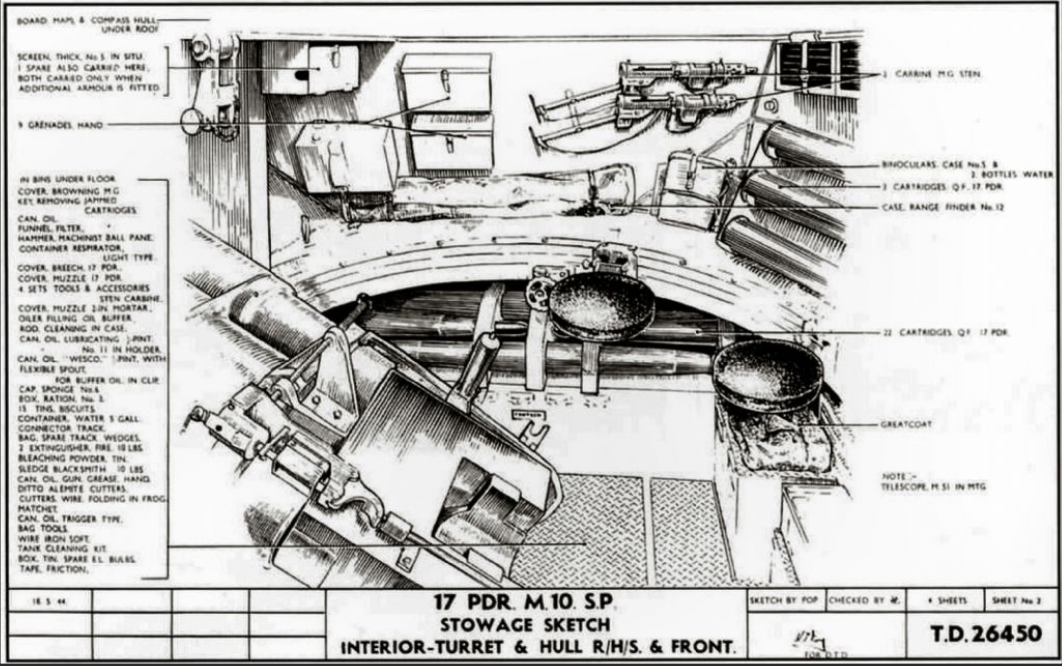
Turret interior

Turret interior, rear
Production
The British Army received 845 M10s until late 1943, but of the second version of the M10, (T71) designed to carry the M1 gun straight away, which needed more modifications to carry the 17 pounder. Of the planned conversion of some 1,000 M10s into Achilles for D-Day Operations, only 124 were ready when the vessels landed them on the beaches of Sword and Gold: Conversion only started indeed in April 1944. Conversions afterwards increased so that in December 1944, 816 Achilles had been fielded including 152 for November alone. Instead at D-Day, the British used the standard M10s so the few Achilles units raised, were equipped instead with the M10 as a stopgap measure. Overall, conversions started to decrease in early 1945 as better solution using the same gun were now available such as the Challenger or Comet. Over 1,650 M10s, 1,100 were converted by April 1945 when it ceased for good.The Achilles in action
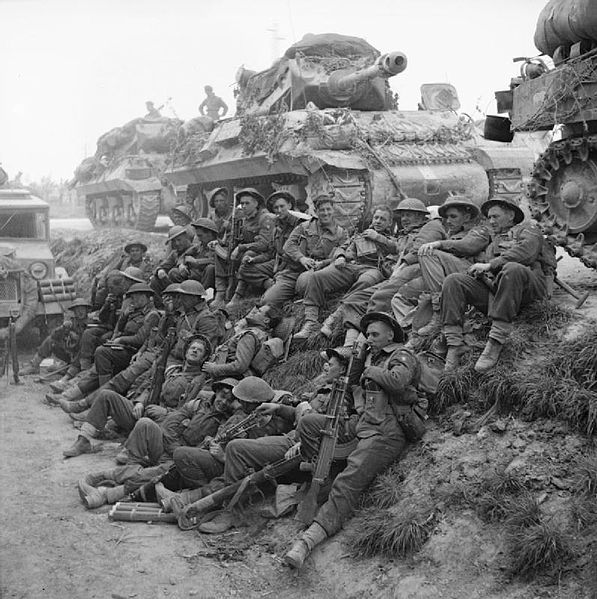
2nd Lancashire Fusiliers covered by Achilles wait for orders forward near Ferrara, Northern Italy, 22 April 1945
In British service the vehicle was not assiilated to tank-hunters in dedicated units, wich was a US doctrine, but rather as self-propelled anti-tank guns. Thus, they were logically operated by regiments of the Royal Artillery. Organization typical of 1944 comprised two batteries with M10s plus two towing the 17-pounder gun. An antitank Regiment comprised two "mobile Batteries comprising one equipped with Achilles adn the other, M10s. The latter was replaced by Achilles during the July-August phases of the battle of Normandy.
One theory was that the two towed batteries would create the "anvil", a backup defense line or ambush, while the "hammer", M10 battery would remain mobile on each flank in the hope of driving the enemy towards the static gun line.
In practice, this rarely was done. In Normandy, the nature of the bocage had these units splitted between the two components, M10s being organically aded instead to regular British tank brigades working with Churchill tanks which had the heneral purpode 75 mm gun (and other 17-pdr conversions such as the Firefly).
The 17 pounder required a new, longer and broader turret counterweight, and a specific, heavy muzzle brake on the barrel's end. Both the longer gun, muzzle brake and turret counterweight allowed allied recoignitn to immediately spot the Achilles over the Wolverine. Once the Germans discovered the new Achilles based on the same M10 carriage, they made them (like the firely) a priority targets. Crews, fearful of the same fate awaiting Fireflies already, adopted the same visual disruption, by trying to disguise the 17 pdr as a shorter gun, by painting both its brake and counterweight.
The British started to use tactically the Achilles as a quickly deployable anti-tank gun, a self-propelled gun able to reinforce any position and engage counter-attacking forces. The towed 17 pounders units, much slower to operate, were dug in instead in a defensive way, all based on map scenarios. Therefore, the Achilles was mostly used defensively, which also allowed an easier first shot. This was in contrast with the much better protected Firefly which often took the lead or tank regiments.
The Achilles turret was manually operated, and thus, quite slow, which was another tactical limitation when operating out in the open. In a defensive role it was also slower to react in case of flanking manoeuvers. They "best match" would be the German Stugs, more easily spotted from their open turrets as the latter had a low profile. It's heavy armour could be still defeated by the 17-pdr. M10 and Achilles were only used offensively in support of Churchill tank units.
Deployed by Royal Artillery and Royal Canadian Artillery units organic to Armoured Division or Anti-tank Regiments, the Achilles had its hour of glory in a specific, notable occasion: B troop, 245th Battery, 62nd Anti-Tank Regiment of Royal Artillery which operated with the Royal Hamilton Light Infantry in Operation Charnwood south of Buron (Battle of Caen, 8–9 July 1944), succeeded in repelling with heavy losses a German counterattack with Panzer IV and Panthers from 12th SS Panzer Regiment. It was a text-book defence, mixing flanking Achilles and a line of towed 17-pdr from the 245th Battery, 62nd Anti-tank Regiment. No less than thirteen tanks were destroyed, for the loss of four Achilles/M10s and four damaged.
A good example of evolution were tge 117, 118, 338, 339 Batteries. By 13 June 1944 in Normandy 118 and 338 were each made of three troops, with towed 17-pdr AT guns, while 117 and 339 had mixed M10 and Achilles in the same numbers. From July 1944, Achilles started to replace regular M10s to make unified troops. By December, the two Batallions were made exclusively of three Achilles 17 pdr troops with each a single M22 Locust light tank for the troop commander while the former towed batteries had been recycled into infantry companies. 338 Rgt. took part in Operation Veritable, clearing the Reichswald in Feb-March 1945, and securing a deeper advance into Germany.
M10 Achilles would soldier on until September 1944, and the rampage of the Falaise Pocket. Afterwards, defensive actions were rare. Achilles were used in a multitude of roles during the British progression northwards, until reaching the Rhine. They were often used as ersatz tanks or artillery fire support. Not to be undone, by that stage, the US Forces were now deploying the far more capable M36 Jackson and M18 Hellcat, making the Achilles les relevant. Despite of this, the large numbers engaged soldiered on until V-Day in Europe. They were not deployed into the far east afterwards, but still stayed in service until the late 1950s, mostly in reserve to face the growing Soviet threat. A post war analysis shown that SP artillery guns were about 3 times as effective as towed guns in 1944–45.
The MORU Report 33 Tank Battle Analysis stated that for M10 in British service (regular M10 and Achilles IC-IIC) that they took part in 27 engagements, and on some vs. Panzer III-IVs, 32 of them engaged 14 tanks, with one "Achilles" lost for 11 destroyed. 56 'Achilles' engaged 39 Tiger and Panther tanks with six lost for 26 claimed, at the mean range of 1090 yards and standard deviation of 715 yards. Stats showed the 17 pdr can defeat the PzKpfW IV/Stug IIII at most ranges and angles.
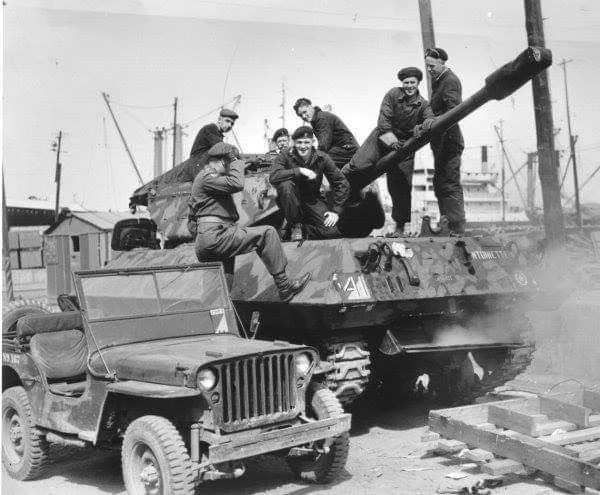
The 17 Pdr SP Achilles were also used by the Canadians in Korea in 1950-51 but apparently they were replaced by Comets afterwards.
As of today, a dozen of these survived between private collections, in storage pending restorations or to working order, and displayed at the Third Cavalry Museum, Aalborg Forsvars- og Garnisonsmuseum , Batey ha-Osef Museum, Bovington Tank Museum, Panzermuseum Munster and Yad la-Shiryon Museum. Some were passed on to the Danish and Dutch armies after the war. The first received 48 M10 17pdr SP Guns from Canada in 1955, under the MDAP. Before delivery, they had been rebuilt at the Montreal Locomotive Works and some were fitted with CDP tracks. They still had their original SCR-508 radio used from 1941 to 1958.
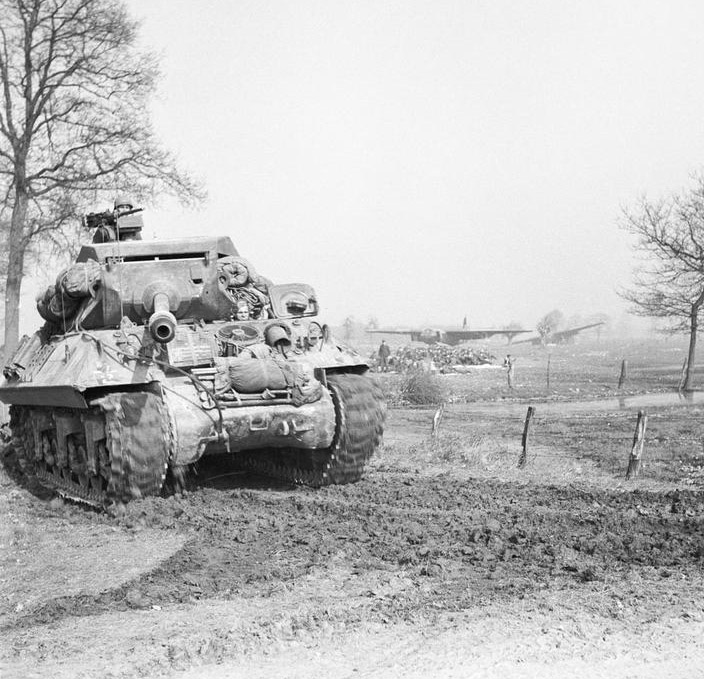
24-31 March 1945, Achilles on the east bank of the Rhine
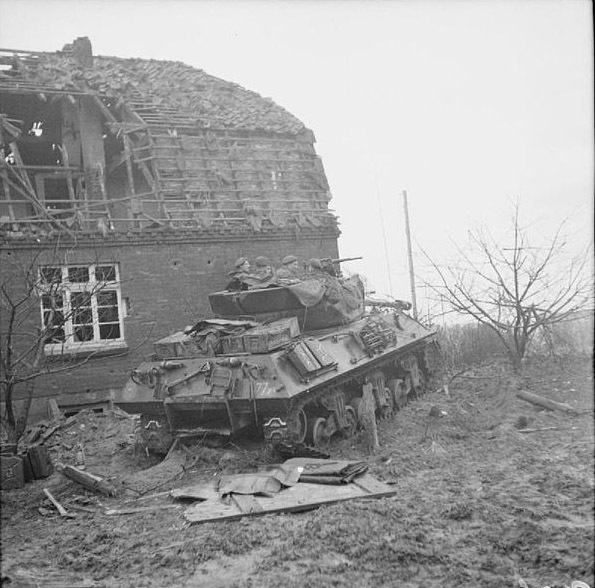
Achilles in North-West Europe, 1944-45
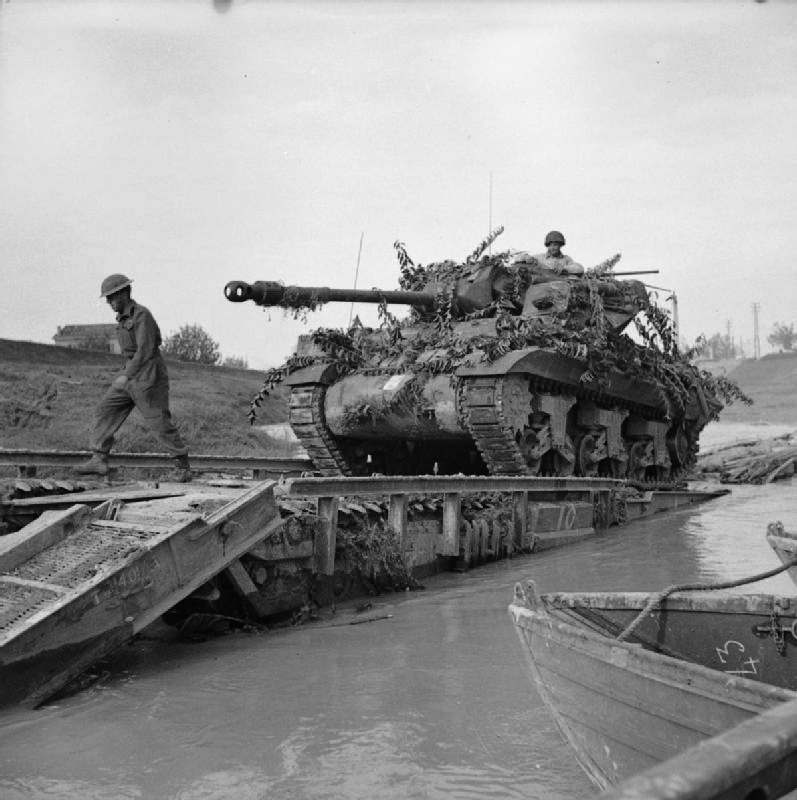
Armoured Ramp Carrier, Achilles
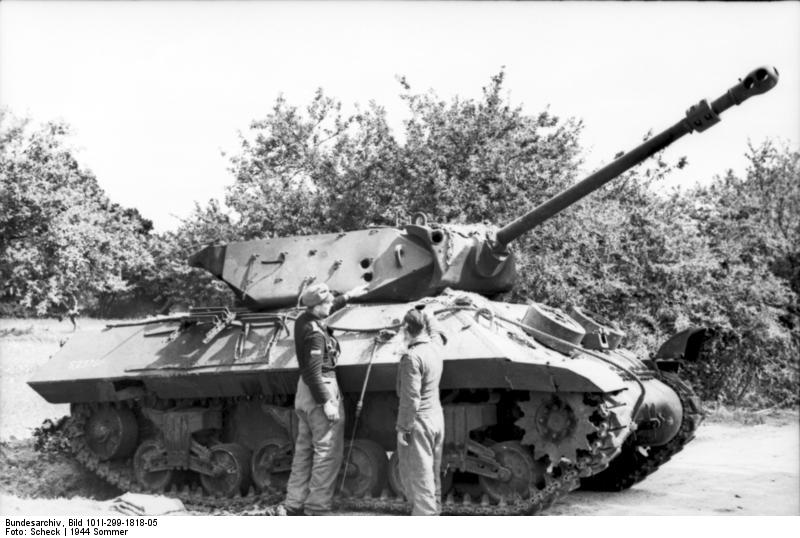
Bundesarchiv: Northern France M10 Achilles
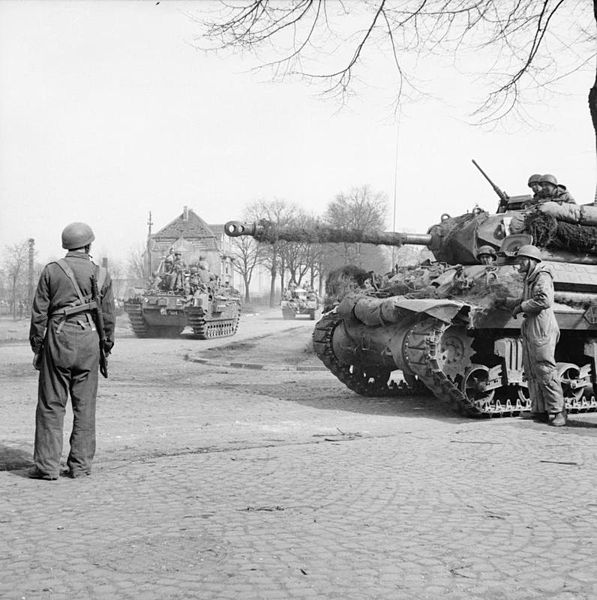
Churchill tanks of 6th Guards ank Brigade carrying paratroopers from the American 17th Airborne Division pass through Dorsten in Germany while an Achilles tank destroyer waits, 29 March 1945
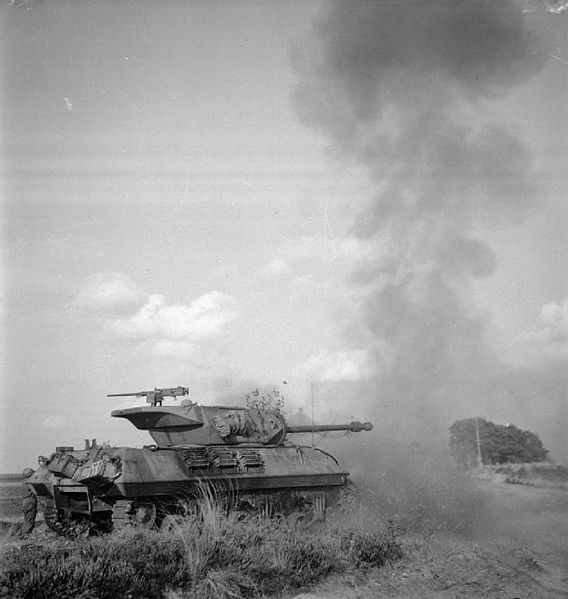
75th Antitank Regiment of the Royal Artillery, 11th Armoured Division Achilles, firing close to Germany Oct 1944 (IWM)
Specifications 17pdr SP, Achilles | Dimensions | 23 ft 8in-1/4 oa x 10 x 8 ft 2 in (7.01m oa x 3.05m x 2.97m) |
| Total weight, battle ready | 29.6 tons (65,000 lbs) |
| Crew | 5 (driver, commander, gunner, loader and assistant) |
| Propulsion | General Motors 6046 diesel (twin 6-71) 375 hp (276 kW) |
| Suspension | Vertical Volute Spring Suspension (VVSS) |
| Speed (road) | 51 kph (32 mph) |
| Range | 186 miles (300 km) |
| Armament | Ordnance QF 17 pounder (76.2 mm), 50 rounds Secondary: .50 cal (12.7 mm) Browning M2HB AA, 420 rounds Tertiary: .303 (7.62 mm) Bren light machine gun |
| Armor | As M10 + additions, see notes |
| Total Conversions | 1,100 |
Src/read More
Henry, Chris (2004), British Anti-tank Artillery 1939-45, New Vanguard 98 Osprey PublishingChris Henry, Brian Delf British Anti-tank Artillery 1939–45, p. 24.
Buckley, J. "British Armour in the Normandy Campaign" Abingdon (2004) p. 171
Achilles 17 Pdr M10 Sp British Tank Destroyer (Armor Photo Gallery No. 14) by Wojciech J. Gawrych
Oliver D (2019) Tank Destroyer Achilles and M10 1944–45 Penn and Sword
MORU Report 33 Tank Battle Analysis H Gee and J H Hutchinson
2nd Army Operational Research Group Report 15 Analysis of Tank Casualties in France 6 June to 31 August 1944 Table XI
Pennycuick K Comparison of Panther and Centurion Tanks Under Heavy Attack War Office
More photos of the Achilles in WW2
Photos of M10s Achilles in Museums
On dday-overlord.com
On Quora
Surviving Achilles on shadock.free.fr
On militaryfactory.com
The Encyclopedia of the Korean War by Spencer C. Tucker, Paul G. Pierpaoli Jr
In Danish postwar service
On 19fortyfive.com
On quora
Italeri Kit review on perthmilitarymodelling.com
M10 Achilles - general query on scalemates
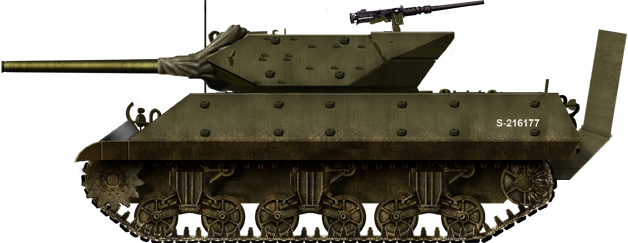
The basic M10 IC in British service: 20th Antitank Regiment, 3rd Infantry Division, Sword Beach, June 1944, Normandy
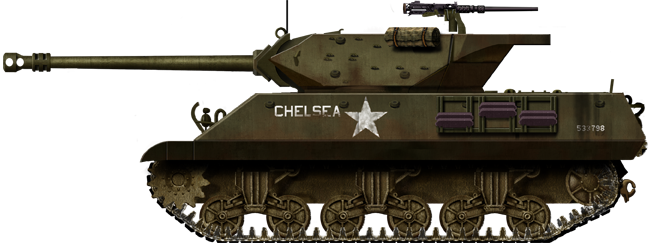
17-Pdr SP Mark I, J-troop, 24th Batallion, 62 Antitank regiment, June 1944
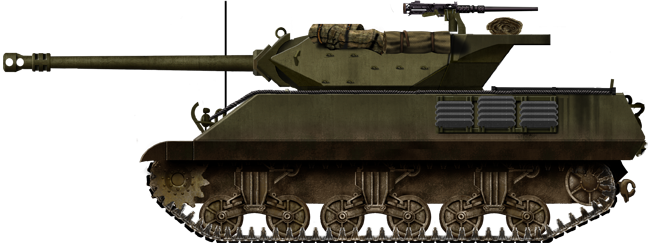
Another M10 Mark IIC Achilles in France, Summer 1944, typically overburdened with haversacks and extra gear.

M10 C-II Rhine Border, winter 1944-45
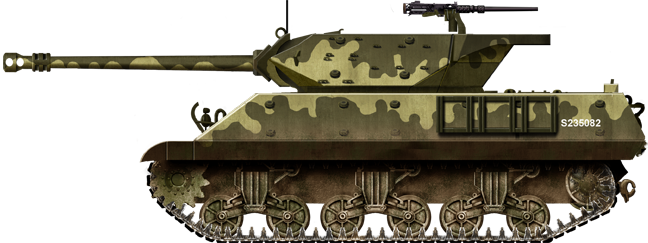
21th Antitank Regt. Royal Artillery Guards TD Batallion, Netherlands fall 1944
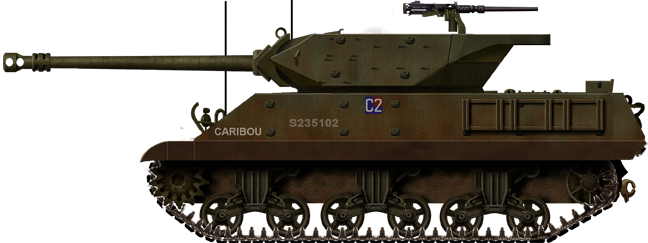
Achilles of the 4th Anti Tank Regt., Royal Canadian Artillery, Netherlands 1945. It is now in the Balmoral Green association, Versailles (France) in running condition but with a fake turret.
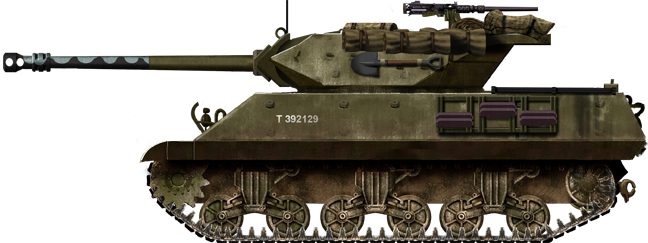
M10 IIC of the Polish 1st Army, 7th Artillery Regiment, 2nd armoured division, Italy May 1945
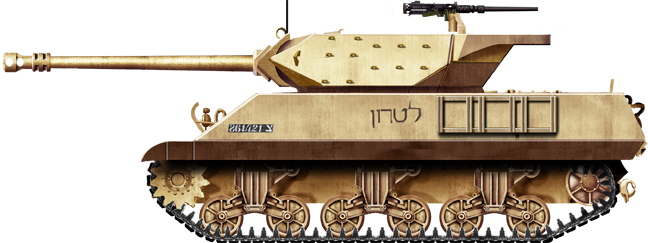
Israeli M10C from the 1956 war
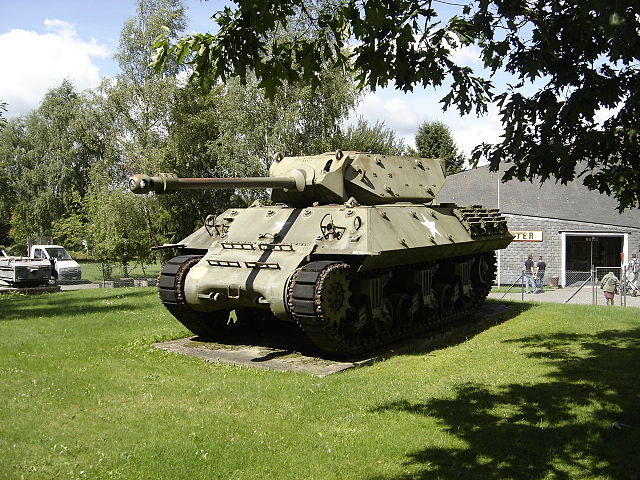
M10 Achillesin the Bastogne Historical Centre
Achilles Tank Destroyer M10 IIC at La Roche-en-Ardenne, Belgium
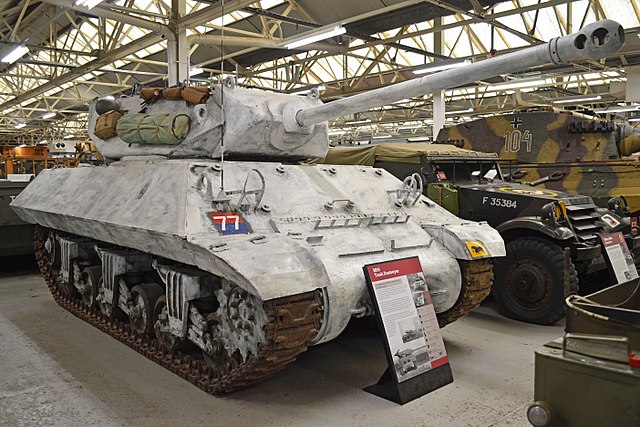
M10 Achilles Ic with winter-paint, Bovington Museum
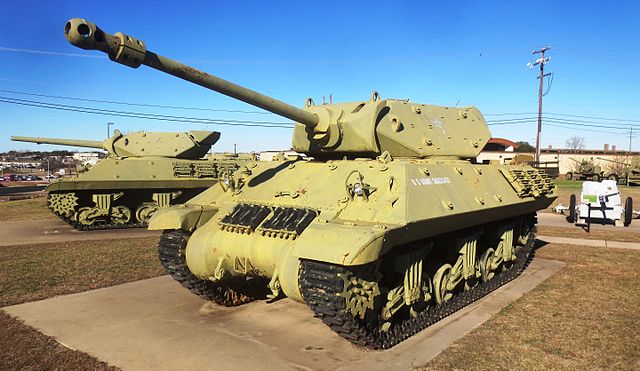
17-pounder Achilles SP Tank Destroyer, 3rd Cav. Museum, Fort Hood, Texas
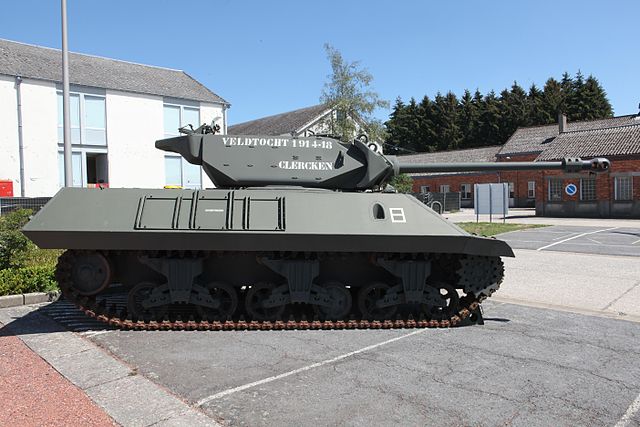
Achilles IC Netherlands IJmuiden Museum by Joost J. Bakker
Camouflaged M10 Achilles IC – Rex & Rod Cadman Collection (UK) in running conditions.
Facebook photo - war in color WW2 Normandy

WW2 Tanks




























WW2 tanks posters

All Tiger tanks liveries.

Panther liveries and variants

WW2 Armour - All tanks











Tanks aces and single tanks series

Find more there

Museums, Movies, Books & Games
The Tanks and Armor in pop culture
Tanks and armored vehicles in general are only really grasped when seen first person: The mass, the scale, it's all there. Explore also the way tanks were covered in the movie industry, in books and in video games.Movies:
Best tanks movie on warhistoryonline.com
On imdb.com
On bestsimilar.com/
miltours.com
liveabout.com/
watchmojo.com
Video Games:
pcgamesn.com
historyhit.com
levvvel.com
vg247.com/best-tank-games
mmobomb.com/
alienwarearena.com


